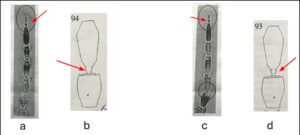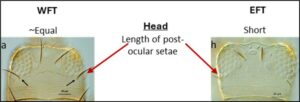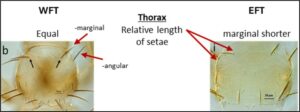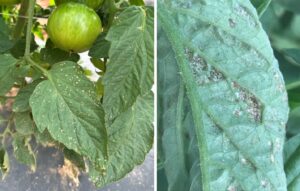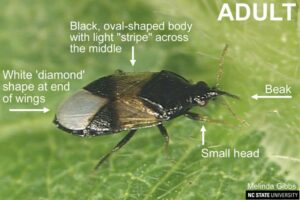Management of Western Flower Thrips in Fruiting Vegetables
go.ncsu.edu/readext?1090022
en Español / em Português
El inglés es el idioma de control de esta página. En la medida en que haya algún conflicto entre la traducción al inglés y la traducción, el inglés prevalece.
Al hacer clic en el enlace de traducción se activa un servicio de traducción gratuito para convertir la página al español. Al igual que con cualquier traducción por Internet, la conversión no es sensible al contexto y puede que no traduzca el texto en su significado original. NC State Extension no garantiza la exactitud del texto traducido. Por favor, tenga en cuenta que algunas aplicaciones y/o servicios pueden no funcionar como se espera cuando se traducen.
Português
Inglês é o idioma de controle desta página. Na medida que haja algum conflito entre o texto original em Inglês e a tradução, o Inglês prevalece.
Ao clicar no link de tradução, um serviço gratuito de tradução será ativado para converter a página para o Português. Como em qualquer tradução pela internet, a conversão não é sensivel ao contexto e pode não ocorrer a tradução para o significado orginal. O serviço de Extensão da Carolina do Norte (NC State Extension) não garante a exatidão do texto traduzido. Por favor, observe que algumas funções ou serviços podem não funcionar como esperado após a tradução.
English
English is the controlling language of this page. To the extent there is any conflict between the English text and the translation, English controls.
Clicking on the translation link activates a free translation service to convert the page to Spanish. As with any Internet translation, the conversion is not context-sensitive and may not translate the text to its original meaning. NC State Extension does not guarantee the accuracy of the translated text. Please note that some applications and/or services may not function as expected when translated.
Collapse ▲Background
Thrips are small, slender insects (1-2 mm long) belonging to the order Thysanoptera (meaning “fringe-winged”). More than 6,000 thrips species have been described worldwide. Some of them are among the most widespread and economically significant pests in vegetables, fruits and greenhouse ornamental crops.
Thrips species commonly found in vegetables in the mid-Atlantic and southeastern United States include western flower thrips (WFT, Frankliniella occidentalis, Fig. 1), flower thrips (often referred to as eastern flower thrips, EFT, F. tritici), tobacco thrips (TT, F. fusca) and pepper thrips (Thrips parvispinus), a recently detected invasive species in Florida and other southeastern regions. Among these, WFT poses a severe challenge due to its broad host range, ability to develop resistance to insecticides, and dual mode of damage: directly by feeding on leaves, flowers, and fruits, and indirectly by transmitting tospoviruses, including tomato spotted wilt virus (TSWV). TT can also transmit TSWV and is recognized as a significant early-season pest. The risk and timing of TT outbreaks can be predicted using the Tobacco Thrips Flight and TSWV Intensity Predictor. Although the EFT can be present in relatively large numbers early in the summer (May-June), it is not a serious pest because it does not transmit TSWV. EFT occurs primarily in flowers, rather than on leaves or fruit, and causes only direct damage.
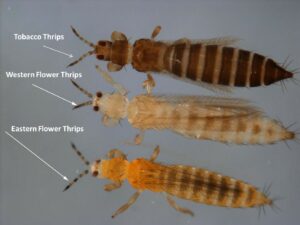
Fig. 1. Thrips species commonly found in vegetable production systems. (Photo: Jack Reed, Mississippi State University)
Distribution
The WFT is native to southwestern North America but has spread throughout the United States and the world, becoming a major global pest in many cropping systems. EFT is native to eastern North America and is commonly found east of the Rocky Mountains, while TT is also widespread and can be found across much of the United States and Canada, primarily east of the Rockies.
While all three species (WFT, EFT, and TT) can occur and feed on foliage as adults, WFT is the only species that can successfully reproduce on tomato foliage. In fact, WFT has accounted for >95% of the total thrips collected from tomato foliage in NC, while EFT and TT make up a small fraction. These three species also all feed in tomato flowers. TT is primarily an early-season pest, typically present during the spring and disappearing from the system by late spring. EFT tends to outcompete WFT in flowers, especially early in the season, resulting in higher EFT: WFT ratios that decline as the season progresses. It is important to note that EFT does not transmit TSWV; therefore, a higher abundance of EFT, particularly when it outcompetes WFT, may contribute to reduced TSWV transmission compared to fields where WFT dominates.
While WFT is potentially the most damaging of the three species, it does not occur in significant numbers in all areas. On an areawide basis, it has an aggregated distribution; i.e., there are hot spots where high populations exist over time. These areas are frequently characterized by a sequence of flowering crops that serve as host bridges throughout the season. Spring wheat, peach flowers, strawberries, and vegetable crops (tomatoes, peppers and cucurbits) are crops that have been identified as important bridge crops. .
Identification
Because thrips species can differ in their behavior, potential impact, and how well they respond to control measures, identification is key to devising management strategies.
WFT: Adult WFT are about 1.2 to 1.5 mm long and range in color from pale yellow to light brown (Fig. 1). There can be variation in the color, depending on the degree of brown shading on the abdomen. They have narrow, fringed wings, often darker at the tips, and small bristle-like hairs on the tops of their bodies (pronotum).
EFT: Adult EFT tend to be smaller (about 1mm long) and more orange than WFT, and they lack the darker wing tips.
TT: Tobacco thrips are dark brown to blackish in color (noticeably darker than WFT and EFT, Fig. 1) and are present early in the season during spring.
WFT and EFT species can appear similar enough that a microscope and identification guide are often necessary to differentiate them. 50× magnification is sufficient to observe distinguishing features.
- Antennae: WFT and EFT both have 8-segmented antennae; however, in WFT, segment V is partially darkened in apical (distal) half and shows less contrast whereas in EFT, segment V is distinctly lighter than segments IV and VI (Fig. 1). Also, the length of segment VIII is 1.5X longer than VII in WFT (Fig. 2a), while the two segments are of equal length in the EFT (Fig. 2c). Also, the base (pedicel) of antennal segment III in WFT is smooth (Fig. 2b), while in EFT it is wider in the center, appearing angular (Fig. 2d).
- Ocular setae: WFT has a pair of post-ocular setae (bristles behind the compound eye) that are as long as the distance between the hind ocelli (Fig. 3a), while EFT has post-ocular setae that are shorter than the distance between the hind ocelli (Fig. 3h). Also, the length of the ocular and post-ocular setae is about the same in WFT, while post-ocular setae are shorter in EFT.
- Thoracic setae: On the thorax, the WFT anteromarginal (inner) and anteroangular (outer) are about equal length (Fig. 4b), but in EFT, the inner setae are shorter than the outer (Fig. 4i).
(Figures 2-4: Photos adapted from Funderburk et al. 2019, and this handout was prepared by Tom Bilbo, Ph.D., Clemson University)
Description and Life Cycle
WFT has six life stages: the egg, two motile larval stages, a prepupa, pupa stage, and the motile adult (Fig. 5). WFT females can lay 150-300 eggs over their lifetime. Eggs are tiny, smooth, and translucent, and are inserted into plant tissues such as leaves, bracts, or petals, making them difficult to detect. In fact, it is necessary to stain eggs and view them under a microscope.
The larval stages resemble the adult in size and shape, have red eyes, and actively feed on leaves and flowers. As they transition into prepupal and pupal stages, they stop feeding. Pupation typically occurs in the soil or growing media. During the pupal stage, wing buds become more pronounced, and the antennae fold back over the head, signaling the final phase before adulthood. Under warm conditions (around 86°F, or 30°C), development from egg to adult takes about 2 weeks. After emergence, the adult can live up to 4-5 weeks, continuing to feed and reproduce.

Fig. 5. Life cycle of western flower thrips. Source: https://www.biobee.com/pests/western-flower-thrips/
WFT can survive North Carolina winters as both adults and larvae, though reproduction slows during the coldest months. Populations are lowest in December and January but begin to build again by March and April as temperatures warm. Winter wheat and other grasses serve as overwintering hosts, allowing thrips to persist until spring crops are planted. While TT are usually more abundant on wild hosts, WFT are consistently present and ready to move into crops early in the season. In early spring, strawberries, oats, and wheat act as key hosts where WFT populations build up just before their dispersal to newly planted tomatoes and peppers in late spring and early summer.
Damage
Both larval and adult thrips cause damage to leaves, flowers and fruit. Damage to leaves results in a speckled appearance that, under large populations, can cause severe scarring (Fig. 6).
Damage to fruit can take several different appearances, depending on the species involved, when damage occurs, and the intensity of the population. Thrips will feed on pollen in tomato flowers, but they can also oviposit in small developing fruit before petals and stamens shed. These oviposition scars develop into small, darkened dimples as the fruit matures (Fig. 7A). On fruit, thrips feeding can cause gold flecking (Fig. 7B), as well as scarring and russeting when populations are large (Fig. 7C).

Fig. 7. A) Thrips oviposition scars on unripe fruit, B) gold fleck caused by thrips feeding, and C) scarring and russeting on mature fruits. (Photos: Steve Schoof and Jim Walgenbach, NCSU)
Indirect damage by transmission of TSWV can also take several forms, depending on the plant age when infected and the TSWV-resistance status of a plant. When a TSWV-susceptible cultivar is infected the first few weeks after planting, symptoms include stunting, blackening/bronzing of leaf tissue (Fig. 8A), and eventually death of the plant. Plants often do not die when they are infected as they become older, but leaf tissue becomes blackened along with classic discoloration and appearance of ringspots on fruit (Fig. 8A and 8B).

Fig. 8. A) Bronzing symptoms of TSWV on tomato leaves, B) TSWV symptoms on tomato fruit. (Photos: Inga Meadows and Jim Walgenbach, NCSU)
TSWV can be acquired by thrips (i.e., become viruliferous) only in the larval stage when feeding on an infected plant, but there is a latent period so that only adults can transmit the virus. Treating plants with imidacloprid just before setting in the field can reduce the incidence of TSWV spread early in the season, but host plant resistance is generally a more important management strategy. There are tomato cultivars that have been bred for resistance to TSWV, but the gene conferring resistance is limited to vegetative tissue, so it only provides protection against viruliferous thrips feeding on foliage. Thrips feeding in flowers can still transmit the virus to fruit, resulting in classic fruit symptoms.
It should be noted that the incidence of TSWV varies widely among years and locations. This is associated with the amount of inoculum in wild host plants early in the season, which is associated with the primary spread by thrips from weed hosts to crops. The level of inoculum is widely unpredictable; one cannot assume a high incidence in one year will lead to a high incidence the following year.
Management
Choosing the right management strategy depends on which thrips species are present and whether their numbers are above damaging levels. While identifying thrips in the field can be difficult, TT are easier to spot because they are dark brown to black, unlike WFT and EFT. Because EFT is much less of a pest than WFT, identification is important. They usually need to be examined under a microscope to differentiate. It is best to collect thrips in a small vial or jar containing 50% ethanol and have an expert identify them. One tell-tale sign that WFT is present is if you find reproducing populations on leaves, since EFT does not reproduce on foliage.
Monitoring
Yellow or blue sticky cards are useful for monitoring thrips flight activity and densities (Fig. 9). Sticky cards placed around the perimeter or outside of the field help detect area-wide dispersal events. For accurate monitoring to make management decisions, leaf and flower inspection is most useful.
For leaf inspection, choose plants at random across different parts of the field. Inspect older, fully expanded leaves (on the lower part of the plant), and look at the undersides of the leaves where thrips feed. Look for immature thrips, silvering or scarring on leaves (a sign of feeding), and black specks (thrips feces). For flower inspection, place an index card under a flower and tap the flower to remove thrips onto the card.
It is important to note that WFT reproduction on foliage primarily occurs in tomatoes, not peppers. Provisional action thresholds are an average of 1 to 2 immature thrips per tomato leaflet or >6 adult WFT per pepper flower.
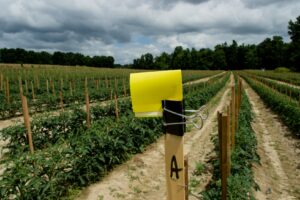
Fig. 9. Yellow sticky cards for monitoring thrips populations in tomatoes.(Photo: Stephen Schoof, NCSU)
Biological control
There are numerous biological control agents (BCAs) such as minute pirate bugs, predacious mites, entomopathogenic fungi, and nematodes that can be incorporated into integrated pest management (IPM) programs. The most effective natural enemy of WFT is the insidious flower bug (Orius Insidiosus, Fig. 10), a species of minute pirate bug, which prefers to prey on WFT adults. These are more effective in peppers and eggplants than in tomatoes, because the bugs have difficulty navigating the dense trichomes on tomato foliage and entering flowers due to the structure of the stamens. Insidiosus flower bugs are particularly effective in suppressing WFT in pepper flowers when selective insecticides are used for the management of other pests.
Cultural control
Cultural control involves practices like managing alternate hosts, such as weeds and grasses, where thrips can overwinter. Strawberries and wheat (and other small grain crops) are two key hosts that facilitate the buildup of WFT in the spring, just before they disperse to newly planted tomatoes when the grain crops dry down. Avoiding planting tomatoes adjacent to these spring reservoirs of WFT can help reduce the initial infestation intensity in vegetables. If crop removal before heading (with herbicides or disking the crop into the soil) is an option, that will also prevent thrips buildups.
Another approach to avoid or delay WFT infestations in fruiting vegetables is using ultraviolet (UV)-reflective mulches (Fig. 11). Reflective mulches interfere with thrips’ ability to locate host plants, making them less likely to settle on crops. These are more effective early in the crop before the canopy covers the mulch and reduces its reflective surface. An added benefit is that reflective mulches can lower WFT populations in flowers, where they are difficult to control even with insecticides. This can also help to suppress transmission of TSWV. However, UV-reflective mulches are more expensive and harder to dispose of than regular plastic mulches, so a cost-benefit analysis should be done for each specific situation.

Fig. 11. Different types of mulches evaluated for management of WFT in tomato production. (Photo: Stephen Schoof, NCSU)
Chemical control
Despite the development and use of various management practices, chemical control remains an essential and most common method to manage WFT in vegetables. Table 1 lists registered products available for use in tomato and pepper, and summarizes their relative effectiveness against WFT. Unfortunately, there are few products that have high levels of efficacy against WFT. Also, insecticide resistance can affect the efficacy against localized populations. Refer to the Southeastern Vegetable Crop Handbook for crop-specific recommendations.
Table 1. Insecticides and mode of action (MOA) for management of western flower thrips in fruiting vegetable crops.
| MOA CLASS | ACTIVE INGREDIENT | TRADE NAME | RATE/ACRE | EFFICACY* RATING | REMARKS |
| 1A | Methomyl | Lannate LV | 1.5 to 3 pt | VG | Quick knockdown activity with short residual activity. Most effective at suppressing thrips in flowers. Lannate has a 48 hr re-entry interval. |
| 1B | Dimethoate | Dimethoate 4EC | 0.5 to 1 pt | G | Dimethoate has a 48 hr re-entry period and 7 day preharvest interval. Not for use on eggplant. |
| 5 | Spinosad | Entrust SC | 3 to 5 fl oz | G | OMRI approved. |
| 5 | Spinetoram | Radiant SC | 6 to 10 fl oz | VG | Effective for foliar control of thrips. |
| 6 | Abamectin | Agri-Mek SC | 1.75 to 3.5 fl oz | F | For suppression of thrips on foliage. |
| 15 | Novaluron | Rimon EC | 12 fl oz | G | For suppression of immatures on foliage. |
| 21A | Tolfenpyrad | Torac EC | 21 fl oz | F | For suppression of thrips on foliage. |
| 28 | Cyantraniliprole |
Verimark SC Exirel SC |
10 fl oz | F | Verimark is for soil application and Exirel for foliar sprays. Will provide suppression on foliage. |
| 28 | Cyclaniliprole | Harvanta EC | 10.9 to 16.4 fl oz | F | For suppression of thrips on foliage. |
| 29 | Flonicamid | Beleaf SC | 2.4 to 4.8 oz | VG | For control of thrips on foliage. Activity is delayed 4 to 7 days after application. Soil applications are less effective than foliar sprays. |
| *Efficacy ratings can vary depending on areas with insecticide-resistant populations. | |||||
Systematic products like Beleaf (flonicamid) and Verimark (cyantraniliprole) are absorbed by the plant and offer protection by targeting thrips feeding on plant (foliage) tissues. Both of these products can also be applied to the soil through drip chemigation for translocation throughout the plant. However, these chemicals do not accumulate in flower tissue; they will only suppress foliar populations. Other products like Radiant (spinetoram) and Lannate (methomyl) are contact insecticides that act on exposed individuals and are also effective against foliar infestations. They can also help manage thrips in flowers; however, their effectiveness depends on how often thrips are exposed, since thrips feed and hide within the tomato’s complex flower structure. It is important to rotate insecticides with different modes of action (based on IRAC group) and integrate them with cultural and biological control methods, as overreliance on similar products can lead to resistance development. For example, field-evolved resistance to Radiant has been reported in WFT populations in tomato and pepper production areas in North Carolina.
Further Reading
Integrated pest management in Western flower thrips: past, present and future https://doi.org/10.1002/ps.4531
Western Flower Thrips in Greenhouses: A Review of its Biological Control and Other Methods https://biocontrol.ucr.edu/western-flower-thrips
The western flower thrips https://ipm.uga.edu/files/2020/05/Western-Flower-Thrips.pdf
Invasion Biology, Ecology, and Management of Western Flower Thrips: https://doi.org/10.1146/annurev-ento-011019-024947
Sampling for Estimating Frankliniella Species Flower Thrips and Orius Species Predators in Field Experiments https://dx.doi.org/10.3791/59869
A Photo-Based Key of Thrips (Thysanoptera) Associated with Horticultural Crops in Florida https://doi.org/10.1653/024.100.0208
Frankliniella occidentalis (Pergande) integrated pest management programs for fruiting vegetables in Florida https://scijournals.onlinelibrary.wiley.com/doi/abs/10.1002/ps.3389
Managing thrips and tospoviruses in tomato https://journals.flvc.org/edis/article/view/119372/version/54305/134156




